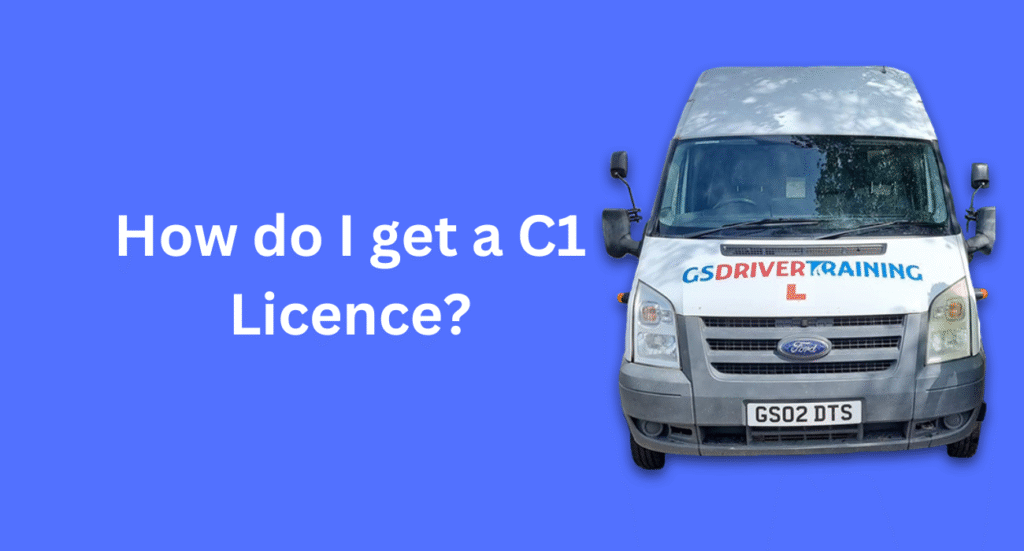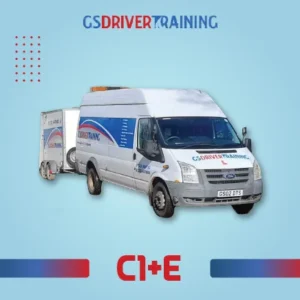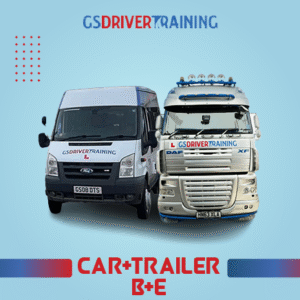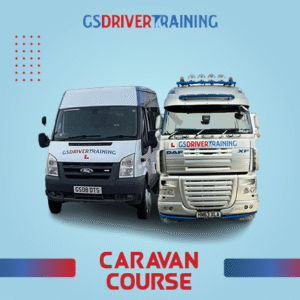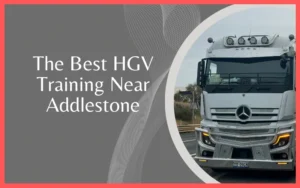How do I get a C1 Licence?
A C1 licence, which allows you to drive medium-sized vehicles, typically involves a specific process and requirements in the UK. Since you’re located in Surrey and have an interest in HGV training, here’s a general guide on how to get a C1 licence in the UK:
Eligibility
- Be at least 18 years old.
- Hold a valid UK car (Category B) driving licence.
C1 Medical Examination
You’ll need to undergo a medical examination by a registered physician to ensure you meet the medical standards required for driving larger vehicles. A registered physician is found on the DVSA (Driver and Vehicle Standards Agency) website.
C1 Provisional Licence Application
Visit the DVLA Website: Go to the DVLA (Driver and Vehicle Licensing Agency) website at www.gov.uk
Find the Appropriate Form
Look for the specific form needed to apply for a provisional C1 licence. In most cases, this is form D2 (Application for a driving licence for a lorry, minibus, or bus). You can usually download the form from the DVLA website or request a physical copy by calling the DVLA’s contact centre. Complete the application form accurately and provide all the required information. Be sure to follow the instructions carefully. You’ll likely need to provide documents such as proof of identity, proof of address, and your current driving licence (Category B). A fee is typically associated with the application for a provisional C1 licence. Check the current fee on the DVLA website and include it with your application.
Submit Your Application
If applying online, follow the online application process and make any required payments electronically.
If applying by post, send your completed application form, supporting documents, and payment to the address specified. The DVLA will process your application, which may take a few weeks. You will receive a confirmation once your provisional C1 licence is issued. Once you have your provisional C1 licence, you can start training with an approved training provider in Surrey.
Provisional Entitlement
Provisional Entitlement Explained
Provisional entitlement refers to a limited driving privilege granted to individuals who are in the process of learning to drive or upgrading their driving qualifications. This provisional status allows them to practice driving on public roads under certain conditions. In the context of the UK and other countries, provisional entitlement is often associated with learner drivers, particularly those seeking to obtain a specific category of driving licence, such as the C1 licence for medium-sized vehicles. Learner drivers, typically new drivers or those aiming to acquire additional driving qualifications, must first obtain a provisional driving licence.
This provisional licence authorizes them to drive a vehicle, but with certain restrictions and requirements. Drivers with provisional entitlement are usually required to be supervised by an experienced and fully qualified driver, often referred to as a supervising driver. This experienced driver plays a crucial role in providing guidance and ensuring the safety of the learner driver during practice sessions. Vehicles driven by individuals with provisional entitlement often display learner plates or L plates. These plates indicate to other road users that the driver is in the learning phase and may require extra caution and patience.
To progress beyond provisional entitlement, learners typically need to pass both theory and practical driving tests. Successful completion of these assessments demonstrates the driver’s competence and understanding of road safety regulations and driving skills. Provisional entitlement may be associated with specific driving licence categories, such as the C1 licence for medium-sized vehicles. The requirements and conditions for provisional entitlement can vary depending on the intended category.
Eligibility for provisional entitlement can also depend on the driver’s age and health status. For example, drivers seeking a C1 licence may need to meet specific age and medical standards. It’s important to note that provisional entitlement is subject to legal and regulatory frameworks specific to each country or region. Therefore, drivers must familiarize themselves with the relevant rules and requirements outlined by their local driver licensing authorities, such as the DVLA (Driver and Vehicle Licensing Agency) in the UK.
LGV Theory Test
– The HGV theory test consists of the Multiple-Choice Questions (MCQ) and the Hazard Perception Test (HPT). Invest in official DVSA (Driver and Vehicle Standards Agency) publications or online resources designed for the HGV theory test. The Highway Code contains essential information for all UK drivers. Study it thoroughly as it forms the basis of the theory test.
LGV Multiple-Choice Questions (MCQ)
- Practice MCQ questions to familiarise yourself with the format.
- Pay attention to road signs, vehicle safety, and driving regulations.
- Use mock tests to gauge your knowledge and track your progress.
LGV Hazard Perception Test (HPT)
– The HPT assesses your ability to identify and react to potential hazards.
– Practice HPT scenarios with official DVSA software or online practice tests.
– Focus on scanning the road ahead and clicking when you see a developing hazard.
– Allocate sufficient time for study and practice. Create a study schedule and stick to it consistently. Professional trainers can provide guidance, resources, and practice exams. Regularly review your performance on practice tests and identify weak areas for improvement. Keep abreast of any changes in driving regulations or test formats. Once you feel confident in your knowledge and abilities, book your theory test through the DVSA website or by phone. On the test day, arrive early, bring appropriate identification, and stay calm. After completing the test, review your results to identify any areas that need further attention.
Select an accredited and reputable training provider that specialises in HGV driver training. Review reviews and ask for recommendations. Ensure the training covers all necessary aspects, including theory, practical skills, and road safety. Verify that the instructors are experienced and certified. Look for a program that offers practical training with actual HGVs or simulators to enhance your skills. Understand the duration of the course, including theory and practical components. Training providers should monitor your progress and provide feedback to help you improve. Participate in mock tests and practice drives to prepare for the practical test.
C1 Driving Licence Practical Training
Begin by researching approved C1 training providers in Surrey. You can find a list of approved training centres on the DVSA (Driver and Vehicle Standards Agency) website. Ensure that the training provider is accredited and recognised by relevant authorities. Read reviews and seek recommendations from others who have undergone C1 training. Review the curriculum of the C1 training course. It should cover all necessary topics and skills required for the C1 licence, including vehicle handling, safety procedures, and road regulations. Verify that the instructors are experienced, qualified, and certified to provide C1 training. Ensure the training centre has a fleet of C1 vehicles for practical training.
Check the condition and maintenance of the vehicles to ensure they are safe and suitable for training. Please inquire about the duration of the course, as it can vary based on the training provider and your prior experience. Understand how many hours of practical training are included in the course. Consider your own learning pace and requirements when choosing the duration. Check if the training provider offers flexible scheduling options to accommodate your availability. Inquire about the total cost of the C1 training course, including any examination fees. Be clear about what is included in the fee, such as practical training, theory support, and use of the training vehicle. Once you’ve chosen a training provider, book your C1 training course by following their registration process.
Actively participate in the practical training sessions and follow the guidance of your instructor. Focus on mastering the necessary skills for safe C1 vehicle operation. Take advantage of any mock tests or assessments the training centre provides to gauge your progress. Ask if the training provider offers theory support to help you prepare for the theory test. Before taking the practical driving test, ensure that you are well-prepared through extensive practice and guidance from your instructor. Coordinate with your training provider to schedule the practical C1 driving test when you feel ready.
C1 Practical Test
The C1 practical test is the final step in obtaining your C1 licence, which allows you to drive medium-sized vehicles. Here’s a guide on what to expect and how to prepare for the C1 practical test. The C1 practical test assesses your ability to drive a medium-sized vehicle safely and competently. You will typically take the test using the same type of vehicle you trained with during your C1 training course. The duration of the test can vary, but it usually lasts around 60 to 90 minutes
- The practical test typically includes the following components:
- Vehicle safety checks.
- On-road driving.
- Manoeuvring exercises (Mod 3a Test).
- Independent driving (following signs or verbal directions).
Before the test, you must perform safety checks on the vehicle to ensure it’s in proper working condition. During the on-road driving portion, you’ll be assessed on your ability to handle various road conditions, follow traffic rules, and drive safely. You may be asked to independently follow road signs or verbal directions, simulating real-world driving scenarios. Maintain clear communication with the examiner throughout the test. Ask for clarification if you need help understanding any instructions. Stay calm and confident during the test. Nervousness can affect your performance. Prioritise safety at all times.
Follow road rules, use mirrors effectively, and make appropriate decisions. The examiner will assess your driving skills based on a set of criteria. These include observation, vehicle control, and hazard awareness. After the test, the examiner will provide feedback on your performance, including areas where you excelled and areas that need improvement. You will be informed whether you have passed or failed the practical test. If you pass, you can proceed to obtain your full C1 licence. If you fail, you’ll receive feedback on areas that need improvement, and you can reattempt the test after further training.
CPC Training (if applicable)
Depending on your career goals, you may need to complete the Driver CPC (Certificate of Professional Competence) training. This is often required for those looking to drive commercially for hire or reward.
The Certificate of Professional Competence (CPC) is an essential qualification for individuals who wish to work professionally as drivers of heavy goods vehicles (HGVs) and passenger-carrying vehicles (PCVs) in the UK and Europe. There are two main categories of CPC:
Driver CPC (Initial Qualification)
– This is the qualification required for new drivers looking to enter the industry.
– To obtain the initial Driver CPC, you must pass four modules: two theory tests (one on multiple-choice questions and one on hazard perception) and two practical tests (one on vehicle safety and one on driving ability).
– Once you’ve passed all four modules, you’ll receive your Driver CPC qualification card, which allows you to work professionally as a driver.
Driver CPC (Periodic Training)
– After obtaining the initial Driver CPC, you must complete 35 hours of periodic training every five years to keep your qualification valid.
– This periodic training is designed to enhance and update your skills and knowledge as a driver.
– The training can cover a wide range of road safety, vehicle maintenance, and driver well-being topics.
Key Points about Driver CPC
- The Driver CPC is mandatory for all professional drivers of HGVs and PCVs.
- You must complete the initial qualification to start working professionally as a driver.
- Periodic training is required to maintain your CPC qualification.
- The periodic training can be completed through approved training centres and spread over several years, but you must complete 35 hours every five years.
- It’s important to keep records of your CPC training, as you may be asked to provide evidence during checks by authorities.
- CPC training is essential for both domestic and international road transport operations.
In addition to the Driver CPC, there is also a Transport Manager CPC qualification, which is required for individuals who want to become transport managers or operators of HGV or PCV fleets. This qualification focuses on the management and administrative aspects of transport operations. To ensure compliance with CPC requirements and to find approved training providers, it’s important to visit the official government websites or contact relevant authorities, such as the DVSA (Driver and Vehicle Standards Agency) in the UK, for the most up-to-date information and guidance.
Exemptions from the Certificate of Professional Competence (CPC) for drivers of heavy goods vehicles (HGVs) and passenger-carrying vehicles (PCVs) can vary depending on several factors, including the type of vehicle you drive, your job responsibilities, and your qualifications. Here are some common exemptions and scenarios where drivers may be exempt from the CPC requirements:
- Individuals who do not drive professionally and use HGVs or PCVs for personal use or non-commercial purposes are typically exempt from the CPC requirements.
- Drivers of vehicles with a maximum authorized mass (MAM) or gross vehicle weight (GVW) of under 3.5 tonnes are often exempt from the CPC requirements.
- Drivers of certain agricultural and forestry vehicles used within certain specific contexts may be exempt. However, the exemption can vary depending on local regulations.
- Some specialized vehicles, such as breakdown recovery vehicles, showmen’s vehicles, and certain vintage or classic vehicles used for non-commercial purposes, may be exempt.
- Drivers who use HGVs or PCVs exclusively for non-commercial purposes or community activities, such as sports or religious events, may be exempt.
- Drivers of emergency services vehicles, such as ambulances, fire engines, or police vehicles, may be exempt.
- Members of the armed forces driving military vehicles are generally exempt from CPC requirements.
Please note that exemption criteria can change over time and vary by country or region. It’s crucial to check with the relevant authorities, such as the DVSA (Driver and Vehicle Standards Agency) in the UK, to determine whether you qualify for an exemption from the CPC requirements based on your situation. Remember that even if you are exempt, maintaining a good understanding of road safety and best practices is essential for all professional drivers.
Apply for the C1 Licence:
After passing your practical test, you can apply for the full C1 licence through the DVLA. You’ll need to provide the necessary documentation and pay the appropriate fee. If you plan to drive larger vehicles or pursue a career in HGVs, consider further training and licence upgrades, such as the C+E licence for articulated lorries.
Government consultation on C1 licence Change
As of my last knowledge update in September 2023, there were discussions and consultations in the UK regarding potential changes to the requirements for obtaining a Category C1 license, which allows individuals to drive medium-sized vehicles. These discussions were part of broader efforts to align driving license regulations with safety and competency standards.
To get the most up-to-date and accurate information on any government consultations or changes related to the C1 license, I recommend visiting the official government website for the United Kingdom, which is the Gov.uk website. There, you can find the latest information on any consultations, policy changes, or updates related to driving licenses, including the Category C1 license.
Please keep in mind that government regulations and policies can change over time, and it’s essential to refer to the official government sources for the most current and accurate information on licensing requirements and any ongoing consultations.
FAQ
1. What is a Category C1 driving licence?
A Category C1 driving licence is a type of driving licence that allows you to operate medium-sized vehicles, including motorhomes.
2. Do I need a Category C1 licence to drive a motorhome?
It depends on the weight of the motorhome. If the motorhome exceeds 3.5 tonnes (or 3,500 kilograms), you generally need a Category C1 licence.
3. I have a current driving licence. Can I drive a motorhome with it?
If your current licence includes Category C1 entitlement (usually for licences issued before 1997), you can drive up to 7.5 tonnes of motorhome. Otherwise, you may need to upgrade your licence.
4. How do I upgrade my licence to include Category C1 entitlement for driving a motorhome?
-o upgrade your licence, you’ll typically need to take a medical examination and complete a Category C1 driving test.
5. What is a provisional licence, and how does it relate to a Category C1 licence?
A provisional licence is a learner’s licence that allows you to learn to drive specific vehicle categories, including Category C1. You’ll need a provisional C1 licence before taking C1 lessons and tests.
6. How do I get a provisional C1 licence?
To obtain a provisional C1 licence, you can apply through the UK DVLA (Driver and Vehicle Licensing Agency). You must meet certain age and health.
Also Read: What is a DVLA D1 form?

